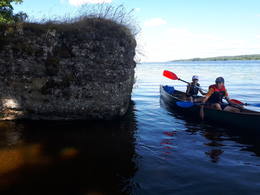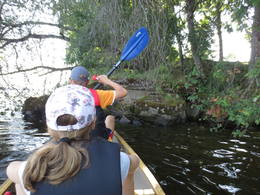Memories from a diary left behind - serving at the Ķegums HPP
Jānis Jaunozoliņš. “Memories from a Diary Left Abroad” (16.08.1944.-13.10.1946.) Fragments.
A passenger train is already waiting at the station, with which the journey to the long-heard-of but not yet seen Keguma begins. Everyone is in a good mood. We feel like real soldiers, even though our companions and commanders are only Germans, whom we quietly call "Fritzes".
Day and night, one of our groups had to go on duty at each stelhung, i.e. four-barreled anti-aircraft gun, searchlight or hot air balloon, stationed around the Ķegums power plant. One of the four-barreled guns is stationed on the roof of the power plant. Our group also has to go out to the balloon and searchlight for the first time. In the morning, everyone has to go to the exit, where the guard change is assigned. We get weapons, ammunition and, led by a non-commissioned officer, we go across the Ķegums bridge to one of the further stelhungs (shelters). We are divided into two at each balloon and searchlight, then we are introduced in detail to the objects to be guarded, tasks and rules, although we had already learned this theoretically and practically during training. But the old shift goes to camp. The day is calm, and the balloons are waiting. It should be explained that the balloons were raised in the air all around the Ķegums power plant and bridge so that enemy aircraft flying low could not make direct bomb hits on the target.
Wherever we go, even to the kitchen for lunch, we have to march with the song. If the song cannot be started after the command, then the command “lie down, get up, run” is given, so we have a chosen song starter.
We are often sent to work on the construction of a new fortification. Two anti-aircraft batteries with about 48 balloons, anti-aircraft guns and searchlights are located around Kegums.
During the entire time spent in Ķegums, not a single enemy plane flew into the bars raised by the balloons, because the balloons did not allow them to fly low. The Ķegums bridge remained intact, even though it was attacked many times.
Andersone, R. 2004. Kegums Hydroelectric Power Plant. p. 74.
Related timeline
Related objects
German army concrete fire point at the Ķegums HPP reservoir at the mouth of the Žega River
Located in the Ķegums HPP reservoir at the mouth of the Žegums River (opposite the Žegums House), on its left bank. One of the most visually and scenically impressive and also better preserved concrete fire points washed by the waves of the Daugava. It can be seen from a greater distance. A footbridge has been built from the shore to the top of the fire point (overgrown with grass). Narrow-gauge railway (?) tracks are built into the concrete walls of the fire point. You can enter it from the footbridge. This is one of the fire points of the German army's World War I defense line on the left bank of the Daugava, which can be more or less traced along the entire length of the left bank of the Daugava. The aforementioned defense line is a large-scale military system that has not yet been truly evaluated as a single entity. The remains of the fire point can be viewed by boating along the Ķegums HPP.
German army concrete fire point on the upper bank of the Ķegums HPP opposite Anduli
It is located about 1.2 km east of a small stream widening (the stream flows into Lejasgrantiņi) at the top of the steep bank slope of the Ķegums HPP opposite Anduļi. The bank in this place is overgrown with forest and undergrowth, so only a keen observer will notice this fire point from the side of the reservoir. The fire point is well preserved, as it has not been damaged by bank erosion. This is one of the fire points of the German army's World War I defense line on the left bank of the Daugava River, which can be more or less traced along the entire length of the left bank of the Daugava River. The aforementioned defense line is a large-scale military system that has not yet been properly evaluated as a single entity. The fire point can be viewed by boating along the Ķegums HPP, as it is located on private territory.
Remains of a German army concrete fire point in the Ķegums HPP reservoir opposite Sidrabiņi
Located about 0.25 km east of the Ķegums HPP reservoir bay near Silapūpēži, towards Jaunjelgava, opposite the Sidrabiņi farm. The fire point has partially sunk into the water and broken into several parts, resembling a pile of construction debris. The bank is overgrown. This is one of the fire points of the German army's World War I defense line on the left bank of the Daugava, which can be more or less traced along the entire length of the left bank of the Daugava. The aforementioned defense line is a large-scale military system that has not yet been fully evaluated as a single entity. The remains of the fire point can be viewed by boating along the Ķegums HPP. About 150 m west of the Daugava bank, the remains of another fire point have sunk into the water.







